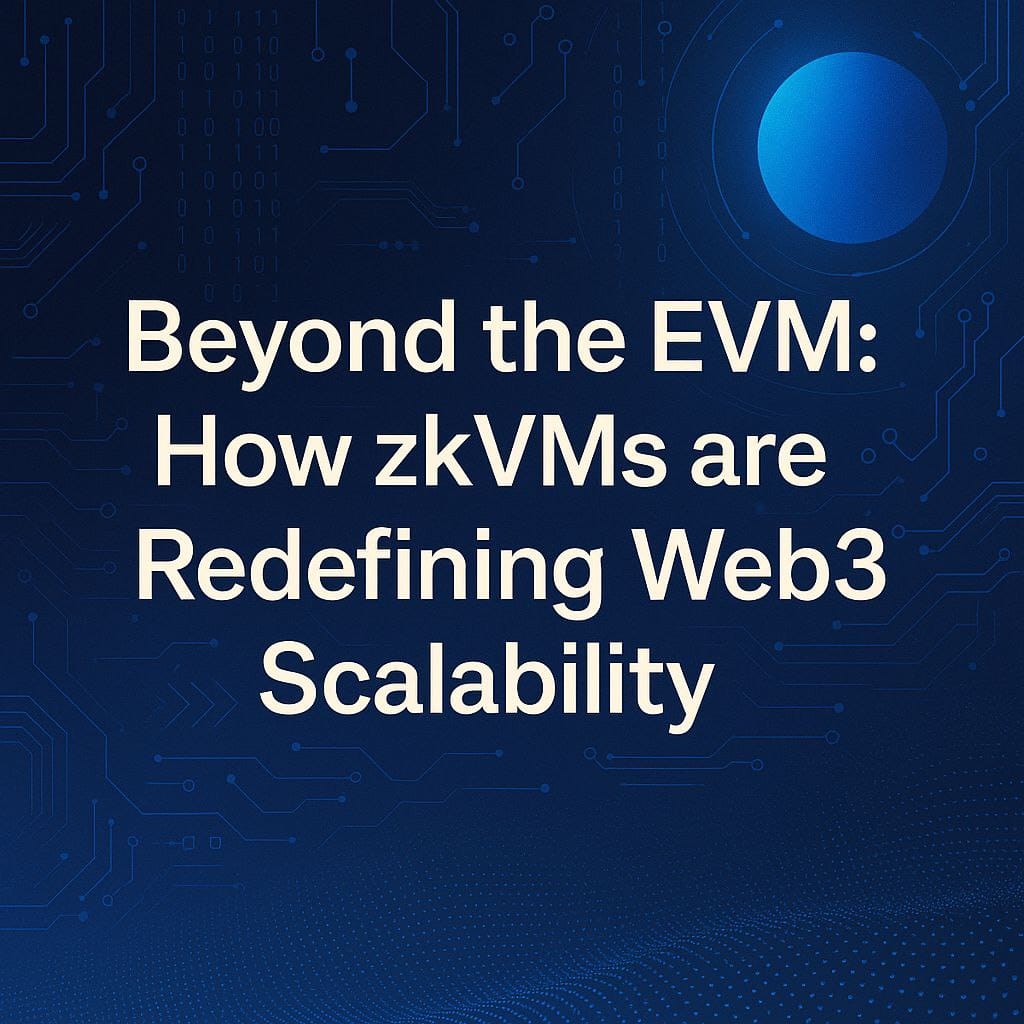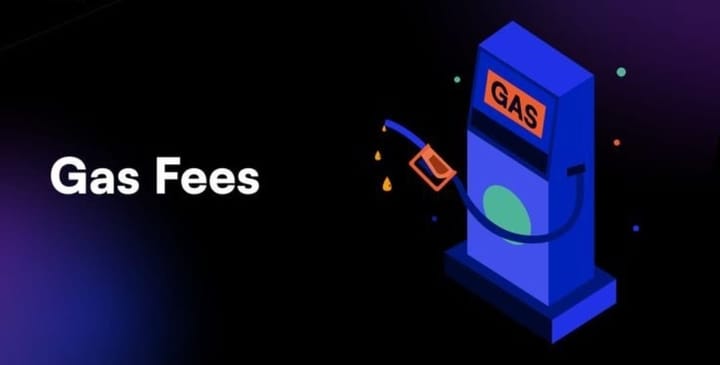Beyond the EVM: How zkVMs are Redefining Web3 Scalability

Web3 stands at a crossroads. While blockchain offers the potential for decentralization and trustless systems, its scalability challenges—high costs, low speed, and development hurdles—threaten to limit its impact. The Ethereum Virtual Machine (EVM), the execution environment for Ethereum smart contracts, exemplifies these challenges. Imagine a Web3 that can handle the transaction volume of the internet itself. Zero-Knowledge Virtual Machines (zkVMs) make this vision attainable. A new whitepaper from LayerZero Labs and Succinct highlights how zkVMs power Verifiable Applications (vApps) through efficient, verifiable computation, achieving significant performance gains compared to the EVM. In this article, we'll explore the mechanics of zkVMs, their importance for scalable Web3, and how Succinct's SP1 zkVM optimizes performance to unlock a new era of verifiable and scalable applications.
Kindly note that some of the information is derived from the whitepaper released by layerzero, and it will included in the sources attached to this article, feel free to look into it for more context and reference.
What Are Zero-Knowledge Proofs? A Kid-Friendly Explanation
Let's say you have two bags. One bag has only red balls, and the other has a mix of red and blue balls. You want to prove to your friend that you have a bag with only red balls without showing them the bag's contents. You could let your friend reach into the bag many times, and every time they pull out a red ball. The more times they do this, the more convinced they are that the bag only has red balls. But they still don't know how many balls are in the bag or anything else! Zero-knowledge proofs are similar. They let a computer prove it has the right information without giving away any details. In Web3, this is useful for things like voting, where you can prove you voted without showing who you voted for.
The Role of zkVMs in Web3
zkVMs are specialized environments that directly address Web3's scalability bottlenecks. They execute programs and generate zero-knowledge proofs to verify their correctness, achieving significant efficiency gains. Benchmarks from the vApps whitepaper illustrate their transformative potential for scalable computation: up to 832x cycle count improvements over EVM-based approaches, 95% acceleration via precompiles, and 30x throughput increases with GPU optimization. These advancements make zkVMs ideal for scaling blockchain applications, from decentralized finance (DeFi) to gaming and beyond.
Why zkVMs Matter
Scalability Through Efficiency
The EVM's interpreter-based design introduces substantial overhead, severely hindering scalability. The EVM requires up to 832x more computational cycles than native execution for simple programs like Fibonacci. This inefficiency directly limits the scalability of EVM-based blockchains. In contrast, zkVMs like Succinct's SP1 compile programs directly to RISC-V, a standard instruction set, bypassing this overhead and enabling vastly improved scalability. This efficiency allows zkVMs to process complex computations, like proving an entire Ethereum block faster and cheaper, enabling Web3 applications to handle the higher transaction volumes required for mainstream adoption.
Trustless Verification
zkVMs employ ZKPs, specifically STARKs and SNARKs, to create succinct proofs that verify computations without needing to re-execute them. For example, a zkVM can prove a batch of transactions is valid within seconds, and anyone can check the proof on-chain. STARKs offer transparency with no trusted setup, meaning they don't require an initial ceremony to establish trust in the proving system. This is a significant advantage as it removes a potential point of vulnerability. SNARKs, on the other hand, do require a trusted setup, but they produce smaller proofs, which are more efficient for on-chain verification. This trustless model reduces reliance on intermediaries, making applications like cross-chain asset swaps or decentralized voting more secure and transparent. While it's important to note that some applications might still involve other actors (like oracles), the core verification process becomes trustless.
Modularity and Flexibility
zkVMs boast a modular design, isolating components like compilers, runtimes, and provers, which simplifies upgrades and vulnerability patches. Developers can write applications in Rust, leveraging its robust ecosystem, and deploy them across single-chain, inter-chain, or Web2-Web3 hybrid scenarios. This flexibility unlocks diverse use cases, from atomic swaps in DeFi to verifiable gaming leaderboards.
Succinct's SP1: Slashing Overhead Costs
Succinct's SP1 zkVM stands out in the vApps framework, significantly reducing the costs of verifiable computation through innovative optimizations. Here's how SP1 cuts overhead, making Web3 more accessible and affordable:
- Native Rust Execution
- Problem: The EVM's interpreter creates massive overhead, with cycle counts up to 832x higher than native execution for programs like Fibonacci. This drives up proving costs, as more cycles demand more computational resources.
- SP1's Solution: SP1 allows developers to write programs in Rust and compile them to RISC-V for native execution within the zkVM. This eliminates the EVM's interpreter overhead, achieving a 1x cycle count baseline compared to 536x–832x for EVM-based execution. For instance, proving Ethereum block execution with SP1 spends up to 63.31% of cycles on state transitions, which native Rust optimizes significantly.
- Impact: Fewer cycles translate to lower proving costs, reducing the time and energy needed on GPU clusters. This makes deploying vApps cheaper, lowering transaction fees for users and enabling real-time applications like ZK rollups.
- Precompiles for Speed
- Problem: Cryptographic operations, such as elliptic curve arithmetic (bn254) or hashing (SHA256), are computationally intensive in zkVMs, slowing down proof generation and increasing costs.
- SP1's Solution: SP1 uses precompiles—custom circuits tailored for common operations—to accelerate proving. The whitepaper demonstrates SP1's bn254 precompile achieving 95% cycle count improvements for PlonK/Groth16 proof verification and 78% for batch KZG verification. For example, ECDSA recovery, crucial for Ethereum transactions, is optimized to further reduce cycles.
- Impact: By significantly reducing cycle counts, precompiles lessen the computational load, lowering the cost of running GPU-based provers. This efficiency supports high-throughput applications, like proving Ethereum blocks within a single block time.
- GPU Acceleration and Proof Compression
- Problem: Proving large programs demands substantial resources, requiring expensive GPU clusters, while large proof sizes increase on-chain verification costs.
- SP1's Solution: SP1 leverages GPU acceleration, achieving up to 4x throughput improvements over CPUs (e.g., 2906.29 KHz for a 41.5M-cycle). It also supports sharding and recursion, splitting programs into parallel shards and compressing their proofs into a single, succinct proof (e.g., Groth16). This reduces proof sizes by up to 300x for large blocks (278.2M cycles), from 346 MB to 1.5 MB.
- Impact: Increased throughput reduces the number of GPUs needed, lowering operational expenses. Compressed proofs decrease on-chain gas fees, making verification more affordable. These cost savings enable vApps to scale to Internet-scale workloads, like cross-chain DeFi protocols.
- Real-World Impact
- SP1's optimizations make verifiable computing economically viable. By lowering proving costs, SP1 empowers vApps to deploy trustless applications—like inter-chain atomic swaps or verifiable gaming—with reduced fees. For developers, this translates to faster iteration and deployment; for users, it means seamless, affordable Web3 experiences. The whitepaper's vision of Internet-scale applications relies on SP1's ability to make ZK proving as efficient as Web2 computation.
Security and Modularity of zkVMs
Beyond efficiency, zkVMs provide strong security and modularity, essential for Web3's trustless nature:
- Security Trade-offs:
- While zkVMs offer strong security guarantees, it's important to consider the trade-offs between different ZKPs.
- STARKs, as mentioned earlier, offer transparency due to the lack of a trusted setup, making them robust against potential vulnerabilities associated with that setup. However, STARK proofs can be larger than SNARK proofs.
- SNARKs, while producing smaller, more efficient proofs for on-chain verification, require a trusted setup. If this setup is compromised, it could potentially lead to the generation of false proofs.
- zkVM implementations themselves must also be carefully audited to prevent bugs in the compiler, runtime, or prover, which could undermine security.
- Soundness and Completeness: STARKs and SNARKs both guarantee that valid proofs correspond to correct computations (soundness) and that every correct computation can be proven (completeness).
- Implementation Correctness: Open-source zkVMs, like SP1, benefit from community audits. Formal verification and integration with Trusted Execution Environments (TEEs) further mitigate risks, ensuring reliable proof generation.
- Modularity: zkVMs feature a layered design, isolating components like compilers, runtimes, and provers, which allows for upgrades without overhauling the entire stack. This modularity future-proofs vApps, accommodating new proof systems or hardware advancements.
These features establish zkVMs as a secure foundation for applications demanding high trust, such as decentralized identity or financial settlements.
The Future of zkVMs in Web3
zkVMs, driven by innovations like SP1, are poised to redefine Web3 infrastructure. Their ability to scale computation, lower costs, and ensure trustless verification aligns perfectly with the vApps framework's goal of Internet-scale applications.
Concrete Use Cases:
- Decentralized Finance (DeFi): zkVMs can enable:
- Private Transactions: Protecting user privacy in DeFi transactions, similar to how Zcash shields transaction details.
- Scalable DEXs: Building decentralized exchanges that can handle the transaction volume of centralized exchanges.
- Complex Financial Instruments: Creating and verifying complex financial derivatives and on-chain calculations in a trustless manner.
- Gaming: zkVMs can facilitate:
- Verifiable Randomness: Ensuring fairness in games by providing provably random number generation for events like loot drops or card shuffles.
- Provably Fair Outcomes: Verifying the integrity of game results and leaderboards, preventing cheating and ensuring transparency.
- Supply Chain Management: zkVMs can be used to:
- Verify Product Provenance: Tracking products through the supply chain and proving their authenticity and origin without revealing sensitive business data.
- Ensure Ethical Sourcing: Verifying that products are sourced ethically and sustainably.
Imagine a DeFi protocol executing thousands of transactions per second, with each transaction's validity instantly verified by ZKPs, or a gaming platform where leaderboards are transparently validated without revealing player data. Thanks to zkVMs' efficiency and flexibility, these scenarios are becoming a reality.
zkVMs vs. Other Scalability Solutions:
It's important to understand how zkVMs fit into the broader context of Web3 scaling solutions:
- Rollups: Both zk-Rollups and optimistic rollups are Layer-2 scaling solutions that process transactions off-chain and post the results to the main chain. zkVMs can be used within zk-Rollups to provide more efficient and secure verification of those off-chain transactions.
- Sidechains: Sidechains are independent blockchains that run parallel to the main chain. While they can increase transaction throughput, they often have their own security models, which may introduce additional trust assumptions. zkVMs focus on verifiable computation and can enhance the security and trustlessness of sidechains.
zkVMs offer a unique approach to scaling by focusing on verifiable computation, providing a powerful complement to other scaling methods.
Challenges and Future Directions:
Despite the significant progress, zkVM technology still faces challenges:
- Proving Time: Generating ZKPs for very complex computations can still be time-consuming, even with optimizations.
- Complexity: Developing and auditing zkVMs is a complex and specialized task, requiring significant expertise.
- Optimization: Further optimization and hardware acceleration are crucial for achieving real-time performance for a wider range of applications.
Active research areas include:
- Improved Proof Systems: Developing new proof systems with faster proving and verification times.
- Recursive Proof Composition: Enhancing techniques for combining proofs to improve efficiency.
- Hardware Acceleration: Designing specialized hardware (ASICs) to accelerate ZK proving.
Conclusion:
Zero-Knowledge Virtual Machines are truly transformative, not just another tech upgrade. They're a driving force behind Web3's growth, tackling its scalability challenges head-on. By making trustless computation efficient, zkVMs, especially innovations like Succinct's SP1, enable vApps to offer smooth, secure experiences, even at massive scale. SP1's optimizations—with up to 832x faster computation, 95% quicker proofs, and 30x higher throughput—drastically cut overhead, putting verifiable computing within reach for developers and making it cost-effective for everyone. Looking ahead, zkVMs are poised to be fundamental to a decentralized, trust-minimized internet, where privacy, security, and scalability work together seamlessly.
The big question:With zkVMs laying the foundation for a more scalable and trust-minimized internet, what are the most pressing ethical considerations we must address to ensure responsible development and deployment?\
Sources and related content
Verifiable Applications at Internet Scale whitepaper
Chainlink intoduction to Zero Knowledge Proof
Zero Knowledge Roll ups vs Optimism Rollups by Mitosis University



Comments ()